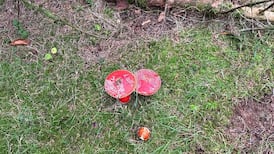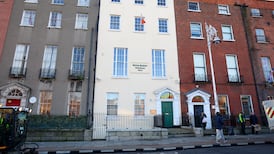It was that spectacular Sunday – here on the west coast, at least – discovered when I took my walk at sunrise. The blaze behind the mountain was about to climb a sky cloudless to all four corners, the affecting blue of forget-me-nots or ancient porcelain. The sea was a paler shade – aquamarine – and stretched like silk to the horizon.
It was our 20th day without one drop of rain. The only moisture in the atmosphere (dew already glistening on the grass) was in the high and feathery vapour trails, fanning back towards North America and following their tiny silver darts across the peak of Mweelrea. Below them – a long way below – were dozens of swallows, dancing south and twittering as they flew.
They have been taking their time this autumn, pausing at any local swirl of midges that has wires on which to perch, and roosting at night in the nearest reed bed. Down in Co Cork, at a big coastal reed bed near Youghal, the naturalist Pat Smiddy watched their roosting habits for years, between July and October, as part of a ringing exercise. The birds stuck to surprisingly regular bedtimes every year, retiring between 11 and 35 minutes after sunset (this, and the end of "civil twilight", at which the centre of the sun is 6 degrees below the horizon, being far more precise than you might think).
The swallows stayed up later in July than in September, to feed longer. The trick to a good mist-net catch of birds in autumn, Smiddy concludes, is to start a taped lullaby of swallow twitters, softly, when the sun goes down.
Thus another, probably useful, morsel was added to the great flow of observation, experiment and conjecture attending the barn swallow, Hirundo rustica, which grows no less in intensity and volume. How the swallow finds its way on migration between these islands and South Africa, however, can be far from easy to grasp. A new book by Anthony McGeehan makes brave – indeed, successful – attempts to help.
Birds of the Homeplace: The lives of Ireland's Familiar Birds (Collins Press, €24.99) follows McGeehan's earlier and equally ambitious Birds Through Irish Eyes, also written with Julian Wyllie, and marks his progress from a Belfast boyhood of birdwatching to the more arcane reaches of ornithology. His appealing trademark style is relaxed and vernacular (in the twittering of a male swallow "the gob is opened wide, evoking a patient in a dentist's chair"). The chapter on migration digests up-to-the-minute papers with titles such as A Behavioural Perspective on the Biophysics of the Light-Dependent Magnetic Compass: A Link Between Directional and Spatial Perception?
Navigational aids
A question mark can still be needed in discussing the two most recently explored navigational aids to bird migration, useful when sun, moon and stars are not readily on view. The reality of bird responses to Earth’s magnetic field has been tested in half a century of clever experiments, using robins and pigeons, among others.
Another possible and interacting aid – perception of polarised light patterns in patches of clear sky – lacks the same body of practical proof, but, with its special intensity at sunrise and sunset, could well help in deciding which way to fly.
McGeehan is painstaking (and fully referenced) in explaining both fields of research, as with other intriguing, if more commonplace, aspects of avian life (how blackbirds stalk worms, how tits find their stocks of food). They serve his confident assertion that “all birds possess an astonishing global positioning system encoded in their genes”.
Another new book tells the story of an American bird that probably never reached Ireland, even in the strongest transatlantic gale, and certainly won't do so now. The last known specimen of the passenger pigeon, Ectopistes migratorius – named Martha, and held in captivity at Cincinnati Zoo – died 100 years ago last month. It remains the most famous example of an extraordinary avian abundance and a reckless human exploitation that offered a lesson to the world.
Pilgrims of the Air (Notting Hill Editions £14.99) is by John Wilson Foster, who is professor of modern Irish literature at the University of Ulster and author and editor of the important Nature in Ireland: A Scientific and Cultural History (Lilliput 1997). He spent his academic career at the University of British Columbia, in Vancouver, but as a keen amateur ornithologist studied birds on both sides of the Atlantic.
His new book is a gem in every sense: small but perfect in the hand, elegantly written and full of evocative, deeply researched interest, both in the bird and American social history. Roaming in millions across the virgin forests of North America, sometimes blotting out the sky, the passenger pigeon belonged to a land – and its rivers and ocean – of an early and now seemingly incredible wild abundance, fatally eroded by servicing the spread of humankind.










